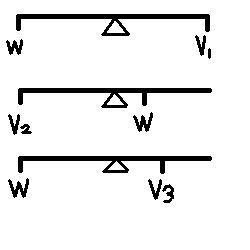Thursday, August 23, 2007
Sometimes an answer don't necessary have a logic behind it.Sometimes,a logic doesn't serve any clues to answer a question.We don't always solve a question to find its answer using a logic,because sometimes,the logic itself is absence.Of course,we also don't use a logic to answer a question,if that question dosen't even have an answer.To that,I present you my personal view on question 11.I feel that putting the question up here allows me to see the question clearly from a 3rd person view-point,and therefore,please enjoy.
One day,David was doing a physics science experiment.The experiment was like this:
The mass of an unknown,W,has same mass as that of another unknown,V1.In comparison of V2,W was heavier.In comparison to V3,W was lighter.Using these clues,determine which upward force faced by the pivot at point O is greatest through out the Vs' when W was balance on a metre rule with an unknown of V1,V2 or V3.
Diagram here:

What troubled me is that,in my point of view,there is a slight different of distance away from the pivot from the W in V2's example and the V3 from V3's.So,I assume that those distance away from the pivot is different.
If we were to make any calculation using substitution,I wouldn't gurantee any correct answers.It just confuse me to have any future conception on the question.Let's look at the question closely.
The mass of an unknown,W,has SAME mass as that of another unknown,V1.In comparison of V2,W was HEAVIER.In comparison to V3,W was LIGHTER.Using these clues,determine which UPWARD FORCE FACED BY THE PIVOT AT POINT O is GREATEST through out the Vs' when W was balance on a metre rule with an unknown of V1,V2 or V3.
So they want us to find the greatest experience upward force faced by the O.It then means that by finding the difference or the similar in either the mass of the unknowns or the moment of force due to a pivot is not really that helpful.This question may not even have a exact answer and logic.But if it were to carry out by real experiment,maybe we could find out the answer.
And so,these are methods I came up with,they are like honeycombs,they may not even be correct.Anyway,I need your imagination to continue with the following methods.
And so,presenting you,method 1.
[Suggesting:N/A(Negligible/Absence)]
We could modify the question to that,by rather let pivot at point O support and balance the ruler,we could use a spring balance to hang the metre rule.But I was thinking if the entire difference in mass will wreak the whole result...
Method 2.
[Suggesting:N/A(Nothing/Ah...]
Let's use some common sense in this method.Imagine your finger at point O,supporting the ruler as a pivot.Now,imagine at which experiment will you feel the strongest force?And which,would you feel the lightest force?
Method 3.
[Suggesting:3 heaviest,2 heavier,1 heavy]
I suggest we implement a new formula to this question.Let's use,the P=F/A formula!As metre rule do have an area(area that is horizontal,nullify to the viewpoint of the diagram),we simply think in a way that,the further away from the pivot,the lighter the mass,will let us experience a smaller downward force.So in this case,as W=V1,the length away from the pivot by the 2 unknown is at the furthest.P=FA,area is bigger,or biggest in the 3 experiments,therefore,pressure experiencing at O might be smallest.Also,the 2 moment at the side are also balance with the same mass and the same distance away from the pivot at O.Therefore,it should be experiencing smallest downward force.(Should Be.)
In experiment 2,W is close to point O,while V2,being lighter,stays futher from point O than W,which W is closer to pivot at point O.Now,let's infer to the experiment 1 for now.In experiment 1,let's imagine if W were to bring nearer to the pivot,so that it follows similarly to experiment 2.Remember that your little poor finger is still in the middle of this experiment :).You would feel an intensive increase in the downward force,because the moment of the force on both side gets decrease(remember you are sliding W to the pivot?V1 would reduce in mass to V2 imaginatively)while W has its mass stays constant.Therefore,you would feel an apparent increase in the downward force.(Poor Fingers...)
Now,going to experiment 3(hang in there buddy xD),we are suppose to move V1 towards the pivot in experiment 1,to the one similar in experiment 3.In this case,V3,significantly heavier,gets increase in mass(imaginatively).You would DEFINITELY experience a OBVIOUS strong downward force.(OUCH.)Thus we infer to experiment 1 and 2,3 is the greatest of all.
Although the question says that,3 different variables,V1,V2,V3 are used,my imaginative method is used as though 1 variable,has a variable mass.(Impossible!)It could serve as a guideline,or a wrong explaination to the real truth of this interesting,yet disturbing question XD.But it was indeed fun solving it.Indeed.
Feel free to rebate my explaination and viewpoint,for I am still asking my physics teacher for the correct explaination.Again,I inform you that,this is my explaination.If it is wrong,please inform me straight after you read this.
This thinking problem seems to use logic and theory more than calculations.It simply answers the logic,not the question itself.Lol.
[UPDATED]
Now,I hereby presenting Method 4 & 5
Method 4.
[Suggesting:1 heaviest,3 heavier,2 heavy]
By using calculations,we substitute mass of W=2N,therefore,V1=x,V2
x.Sub the length of the objects from the pivot:
EG1:W=5cm,V1=5cm
EG2:W=2cm,V2=5cm
EG3:W=5cm,V3=3cm
Don't ask me why,this is what I infer from the diagram.
Thus,moment of EG1=5cmX2N=5cmX[mass of V1],mass of V1=2N
EG2=2cmX2N=5cmX[mass of V2],mass of V2=0.8N
Eg3=5cmX2N=3cmX[mass of V3],mass of V3=3.333333... 3 ...333333N
In physics(especially in this question),we cannot ignore the recurring value,thus we put mass of V3 smaller than a particular value that is slightly smaller than 1/3,which the moment at EG3 whould not be 10N cm(because 3.333333... 3 ...333333N times 3cm will give us a value of 10 N cm,but if V3 is slightly smaller than 3.333333... 3 ...333333,the value of the moment would be any value smaller than 10N cm,thus EG1 has biggest downward force,then EG3,then EG2.
Method 5.
[Suggesting:N/A(Narrative,Abstract)]
We cannot take the mass of the ruler,as negligible.Let's return to the Mass Shiftable Examples in Method 3.This time,we put the W and another Mass Shiftable Unknown on the rear end of the ruler,and balance the pivot at point O,where the two variables are balanced at the same distance.We take up the two weights,and place is right on top of the pivot at point O,forcing and stacking their mass all at the pivot,note that there is increase in mass significantly.
***MOST UPDATED CORRECT THEORY+EXPLANATION***
Method 6.
[Suggesting:1 heaviest,3 heavier,2 heavy]
The logic that falls in this question is that the further away from the pivot of the downward force,there is a increase in moment.The higher the moment determines the strength of the force faced at pivot point O.Therefore,1 is furthest,it has a biggest force at O,then 3,as the W=V3 at a shorter distane,with W=1's W distance.Lastly 2 as the distanceis comparably shorter than any examples for W.
Prisoners of Fate:The Eleventh Wound 8:18 pm



